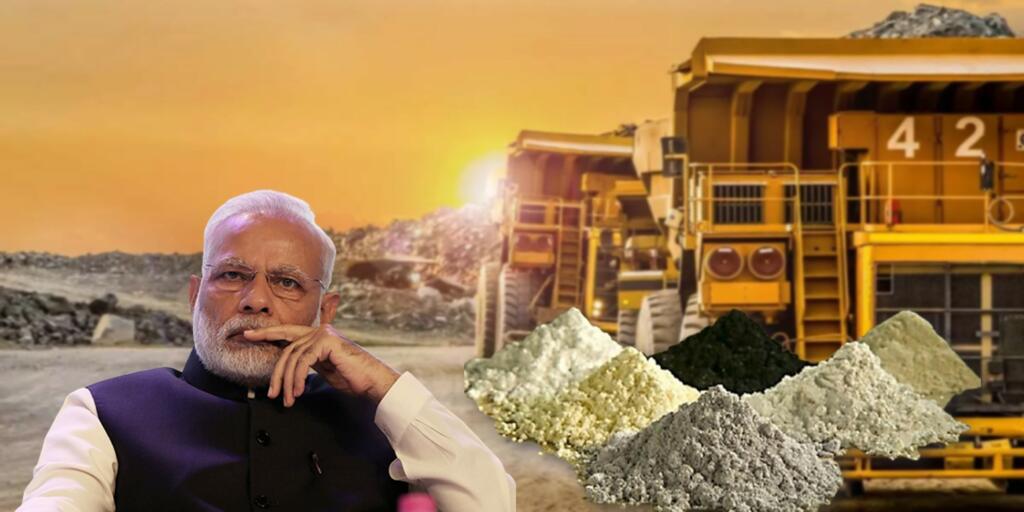Rare earth metals are considered to be just as vital as semiconductors. Semiconductors have been making headlines due to their importance and the potential disruption of their supply chain.
These metals too are critical components in a wide range of modern technologies, including smartphones, electric vehicles, wind turbines and military equipment. The supply of rare earth metals is dominated by China and any disruptions to their supply can have significant impact on global technology and defence industries. As a result, countries and companies are actively seeking to diversify their sources of rare earth metals to mitigate the risks of supply chain disruptions.
What is Rare Earth Metal
The 17 minerals, which include yttrium, scandium, and the 15 lanthanide elements. This composition is essential for the production of magnets due to their magnetic and conductive properties.
For example, Neodymium is responsible for creating the most powerful permanent magnet available. They are used in flat-screen TVs, cell phones, microphones, computer hard drives, electric cars, MRI scanners, speakers, solar panels and wind turbines. It takes 600 kg of rare earth elements for a single wind turbine to be constructed, and 1 kg of the same materials to make an electric vehicle battery.
After the first stage of processing, where raw minerals are crushed into a powder and all their components remain mixed together, a froth flotation process is used to sort the individual elements. This is often a messy undertaking. Further processing using roasting, leaching, and chemical separation is then used to purify the minerals, resulting in a fine powder.
This process does not end here, however. The third stage involves transforming oxides into metals, alloys and magnets. This is something that cannot be done in the USA, as China holds 92 per cent of the conversion capacity and Japan 6 holds per cent.
Read more: India and Australia will together smash the dominance of China
China’s Hegemony
China’s overwhelming strength in the rare earth elements market is a huge cause for alarm for countries such as the USA. In 2021, China’s production of rare earths made up 61% of the global total, at 168,000 tonnes. This is only the start. China is responsible for a huge proportion of the world’s rare earth magnet production, accounting for 85%.
China is estimated to have 44 million tonnes of rare earth reserves, which is significantly larger than Vietnam, Brazil, and India’s combined reserves of 22 million tonnes. The United States, on the other hand, has a much smaller reserve of 1.8 million tonnes and produced only 15.5 per cent of the total rare earth output in 2021, a quarter of China’s production. China experienced an increase in this area during the process of globalisation in the 1980s and 1990s.
Doctor Luisa Moreno, President and Director of Defence Metals Corp, a Canada-based mineral exploration company, told ANI: “I think it was probably around the ’80s when China really started to dominate. Essentially, they basically imported, let’s call it, the processing technology from the United States and other countries. And they started very seriously developing their own resources … They have a lot of processing capacity, and they have many, many deposits, and over the years they perfected how to process it and extract the rare earth in a really competitive fashion.”
Last year, Halimah Najieb-Locke, the Deputy Assistant Secretary for Industrial Base Resilience at the Pentagon, made a statement: “…The reality is, if a country wants to cut off supply for any reason, along with just prioritising themselves, it means that others are at risk. From a national security perspective, we want to prioritise those areas so we can avoid any chokepoints.”
She warned, “There’s a high risk there because you are basically dependent on China for elements that you use in the manufacturing of your equipment, or even weapons and missiles.”
Moreno was questioned by ANI if China has restricted access to rare earths for political purposes before. She responded by saying that in 2010 China famously prevented access to them after Japan arrested a Chinese fishing boat in the Senkaku Islands, an area which China controversially regards as its own.
Moreno noted that China could use economic measures to punish U.S. military firms that assist Taiwan or act against its wishes.
Where India Stands
All these events have proved to be a major problem for the USA and the World, which has resulted in the USA attempting to reduce its reliance on its biggest geopolitical adversary.
These developments have presented a valuable chance to India, as it holds the fifth-largest deposits of rare earth elements globally, twice as much as Australia. However, most of its rare earth requirements are currently being supplied by China in finished form, its geopolitical opponent.
India has a wealth of rare earth deposits, yet it is entirely reliant on imports to meet its needs because mining is only permitted to be done by public sector entities such as the Indian Rare Earth Limited (IREL) and Kerala REL.
However, In July 2021, the Department of Atomic Energy announced the revocation of all exemptions for seabed mineral mining. The Indian Express reported that the Prime Minister, Narendra Modi, had planned a meeting with secretaries from all departments and ministries for September 18, 2021, and the Central government had created a 60-point action plan.
Looking at the current situation, India needs to drastically increase its speed of progress in order to compete with its world known cunning neighbour, China. It is well known that China has boundary disputes with more than 13 countries, even with those countries who do not share the border with China and is constantly threatening India with its presence in the North-East. Therefore, it is essential that India increases its manufacturing capabilities in this sector in order to become self-reliant.
Support TFI:
Support us to strengthen the ‘Right’ ideology of cultural nationalism by purchasing the best quality garments from TFI-STORE.COM
